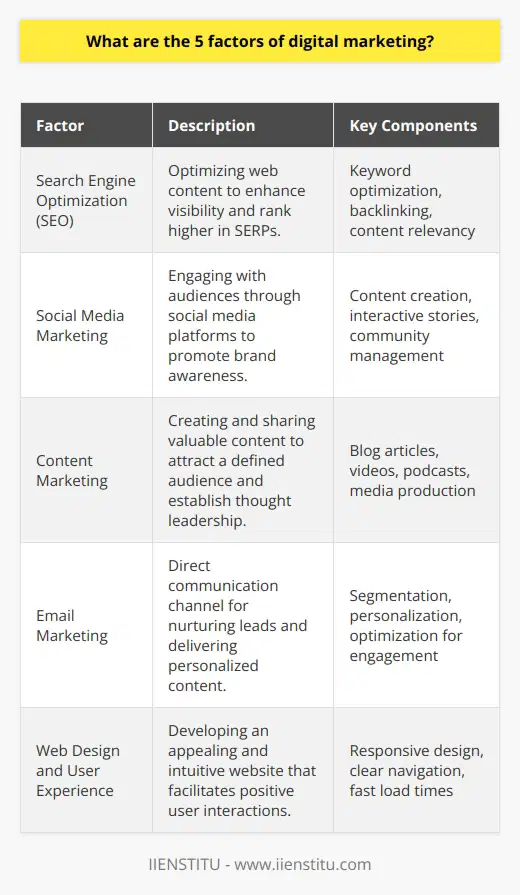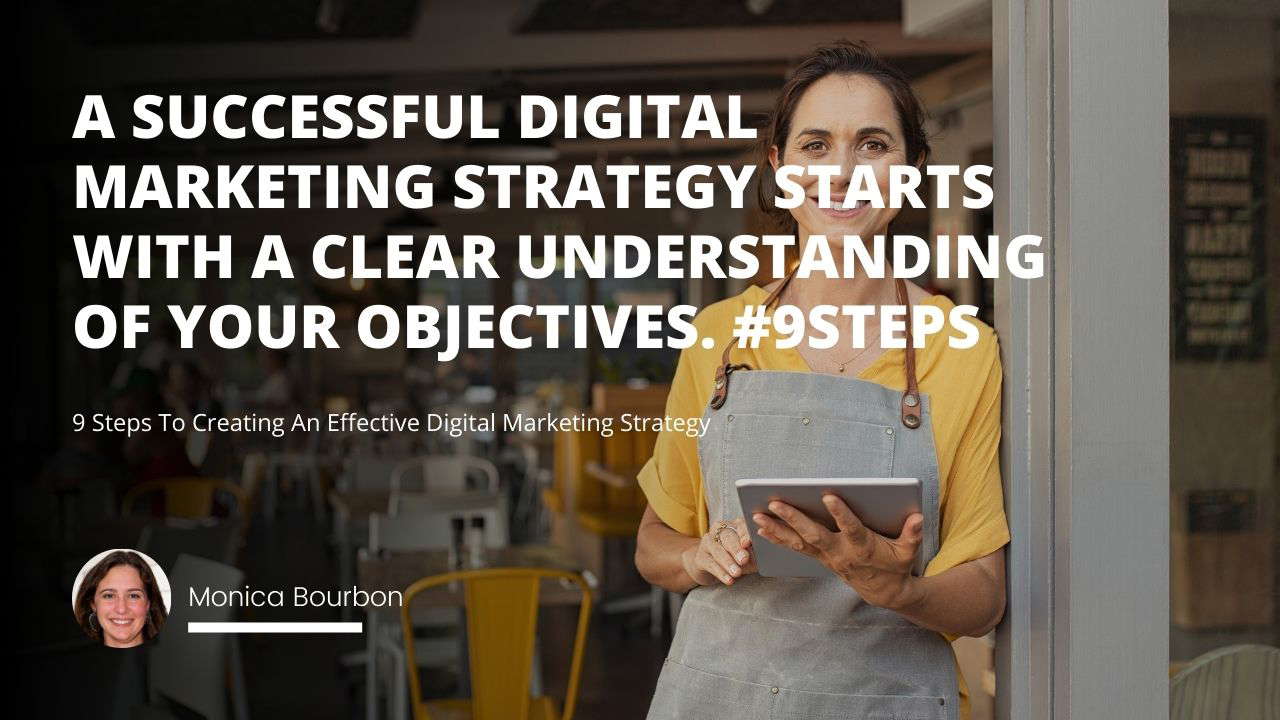
As a business owner, you are well aware of having a solid digital marketing strategy. After all, companies need to have an online presence and use digital platforms to engage with their customers and build their brands in today's technology-driven world. But with so many different tools and platforms available, it can be challenging to figure out which ones to use in your marketing efforts. That's where I come in! Here are five of the essential digital marketing tools that every business owner should be using:
Related Course: Online Digital Marketing Course
1. A content calendar to help you plan and track your content marketing efforts
2. Social media management tools to help you schedule and publish posts on multiple channels
3. A lead generation tool to capture email addresses from website visitors
4. A CRM system to manage your leads and customer data
5. Email marketing software to create and send newsletters and other automated emails
Do you need help creating a digital marketing strategy? These tools will set you up for success.
Your digital marketing strategy is an essential part of your business. It can help you get more customers, find out what they want before making products or services tailored just for them and make the most out of every social media post!
But don't worry - we're here with some excellent tools to set things up so that success happens automatically:
A content calendar to help you plan and track your content marketing efforts.
A content calendar is a vital tool for any content marketer. A content calendar can help you plan and stay on track with your goals by organizing and tracking your content marketing efforts. A good content calendar should include the various types of content you want to create, such as blog posts, videos, emails, and social media updates. It should also outline the frequency with which you will be publishing this content and make it easy to see when each piece should be published. Additionally, a good content calendar will allow you to track your success metrics, such as traffic and engagement rates over time, giving valuable insight into what works and what doesn't. Overall, a well-crafted content calendar is essential for any successful content marketing campaign.
Editorial Calendar
A content calendar is an essential tool for any content marketer. A well-structured editorial calendar can help you plan and track your content marketing efforts, allowing you to stay on top of all your deadlines and ensure that you consistently deliver quality content to your audience. A content calendar can also help you optimize the effectiveness of your campaigns by allowing you to keep track of which kinds of posts tend to perform best and discover patterns or trends in your traffic and engagement metrics over time. Whether you are just getting started with your content marketing efforts or looking for ways to improve your process, a content calendar is invaluable to help you achieve tremendous success.
Google Sheets
Google Sheets is a powerful tool for content marketers, as it offers a content calendar that can help you organize and manage your content marketing efforts. The calendar allows you to easily track the progress of your projects, including which posts are going live on which dates and essential metrics such as audience engagement and site traffic. Additionally, with Google Sheets, you can collaborate with teammates in real-time so that everyone involved has access to all the information they need to succeed. Whether you're just starting with content marketing or looking for ways to improve your existing processes, Google Sheets is an invaluable resource that will help you reach your goals. So why not give it a try today?
Trello
To use Trello, you first create a board and then add columns for each stage of the content marketing process. For example, you might have columns for "Ideas," "Research," "Outline," "Draft," and "Published." You can then add cards to each column, which can contain information such as the piece's title, the target audience, the estimated length, and the due date. You can also add files, images, and links to each card. In addition, you can assign team members to each card and set up notifications to remind you when a task is due. Trello is a flexible tool that can be customized to meet your specific needs. Using Trello, you can ensure that your content marketing efforts are well-organized and on track.
Asana
Asana is an essential tool for anyone looking to improve their content marketing efforts. A content calendar within the platform helps you plan and organize your content creation, making it easier to stay on track with your goals and target audience. With features like scheduling and task reminders, the platform also helps you track your progress and ensure that nothing falls through the cracks. And by bringing all of your team's knowledge and input into one place, Asana enables you to collaborate more effectively and ensure that each piece of content is the best. Whether you're just starting with content marketing or looking for new ways to optimize your existing efforts, Asana can help take your results to the next level. So why not give it a try today?
Airtable
Airtable is a robust content calendar that can help you plan and track your content marketing efforts more effectively. With Airtable, you can create detailed calendars and schedules to organize your time and resources while easily keeping track of all the elements that go into creating successful content. So whether you need to manage guest bloggers, establish editorial workflow, or track your social media efforts, Airtable has the tools you need to create a streamlined and strategic content marketing strategy. So if you're looking for a way to organize better and optimize your content marketing campaigns, Airtable is the tool for you.
Social media management tools to help you schedule and publish.
When managing your social media activities, several powerful tools can help you schedule and publish posts more effectively. One of the most popular options is Hootsuite, which allows you to create custom schedules for different channels and measure your results. Other valuable features include post analysis, audience engagement metrics, and team collaboration functionality.
Buffer
Buffer is a social media management tool that enables you to schedule and publishes content across multiple social media channels quickly. With Buffer, you can connect your Twitter, Facebook, Instagram, and LinkedIn accounts and share your content with just a few clicks. Additionally, Buffer provides valuable insights into the performance of your posts so that you can see what's working well and adjust your strategy accordingly. Whether you're looking to save time on social media or want to optimize your results, Buffer is an essential tool for any digital marketer. So why not give it a try today?
Hootsuite
Hootsuite is another popular social media management tool that offers similar features to Buffer. However, one key advantage of Hootsuite is that it enables you to monitor all of your social media activity in one place. This can be helpful if you want to quickly see how your posts are performing across different channels and make necessary adjustments to your strategy. Additionally, Hootsuite provides users with valuable insights into their audience to better understand who they're reaching with their content. So if you're looking for a tool that can help you save time and improve your social media results, why not give Hootsuite a try?
A lead generation tool to capture email addresses from website visitors
When it comes to generating leads, one of the most effective methods is to capture email addresses from website visitors. This can be done using a simple lead capture form embedded on your website or blog. Once a visitor submits their email address, they can be added to your email list and sent automated marketing messages. Additionally, you can use this data to create targeted marketing campaigns, segment your audience, and even track the results of your efforts. So if you're looking for a way to increase leads and sales, a lead capture form is an essential tool for any digital marketer.
A CRM system to manage your leads and customer data
Once you've captured leads from your website, it's essential to have a system to manage them effectively. This is where a CRM system comes in handy. With a CRM system, you can easily track and analyze your leads and manage your customer relationships over time. This can help you improve lead quality, better understand your customers' needs, and optimize your marketing efforts to maximize ROI. With so many powerful CRM tools available today, there's no reason not to invest in one that can help you grow your business more quickly and efficiently.
Email marketing software to create and send newsletters and other automated emails
Finally, email marketing is essential when it comes to building a successful digital marketing strategy. By creating targeted email campaigns and sending them to a list of engaged subscribers, you can effectively promote your products or services and build lasting customer relationships. Some popular email marketing tools include MailChimp, Constant Contact, and AWeber. With so many options available, it's easy to find the right email marketing solution for your business. So why not start using email marketing to grow your business today?
As you can see, there are several essential tools that any digital marketer needs to build a successful digital marketing strategy. Using the right tools can save time, generate leads, and improve your results. So why not start using these tools today to grow your business?
While this may seem like a lot to manage, it's doable with the right tools. We have a few recommendations for you. First, consider using a content calendar to help you plan and track your content marketing efforts. This will ensure that you are publishing fresh and relevant content regularly. Second, take advantage of social media management tools to help you schedule and publish posts on multiple channels. Third, use a lead generation tool to capture email addresses from website visitors to build your email list. Fourth, invest in a CRM system to manage your leads and customer data. And finally, use email marketing software to create and send newsletters and other automated emails. By using these tools, you'll be well on your way to building a successful digital marketing strategy.
So, what are you waiting for? Get started today!

Frequently Asked Questions
What is the role of data-driven decision-making in formulating a 5-step digital marketing strategy?
Role of Data-driven Decision-making
Effective digital marketing strategy relies on data-driven decision-making, as it provides accurate insights and predictive analytics to enhance marketing efforts. The role of data-driven decision-making can be seen in all five steps of formulating a digital marketing strategy explained below.
Identifying Target Audience
By analyzing demographics, interests, and past interactions, data helps in precisely identifying the target audience. This approach ensures that marketing efforts are directed towards individuals most likely to convert, enhancing return on investment (ROI).
Setting Achievable Goals
Data assists marketers in setting achievable SMART (Specific, Measurable, Achievable, Relevant, and Time-bound) goals to drive digital marketing efforts. Historical performance data and industry benchmarks help in identifying realistic objectives that align with business outcomes.
Developing Relevant Content Strategy
Data-driven insights, such as keyword analysis and user engagement metrics, guide marketers in the production and distribution of relevant and timely content. This tailored approach aims to capture audience attention and elicit desired responses, thereby boosting conversion rates.
Optimizing Channel Selection
Various marketing channels, such as social media, emails, and search engines, serve distinct purposes and cater to different audience segments. Data aids in identifying the best-performing channels and allocating resources effectively, maximizing campaign impact.
Monitoring and Improving Performance
Continuous monitoring of performance data is crucial for evaluating the efficacy of digital marketing efforts, identifying areas for improvement, and making informed decisions for agile optimization. Feedback loops and data-driven insights enable marketers to adapt quickly and maximize their digital strategies' efficacy.
In conclusion, data-driven decision-making plays a critical role in developing an effective 5-step digital marketing strategy, by ensuring that each step is underpinned by accurate and actionable insights. This approach not only results in more efficient marketing efforts but also drives continuous improvement and growth.
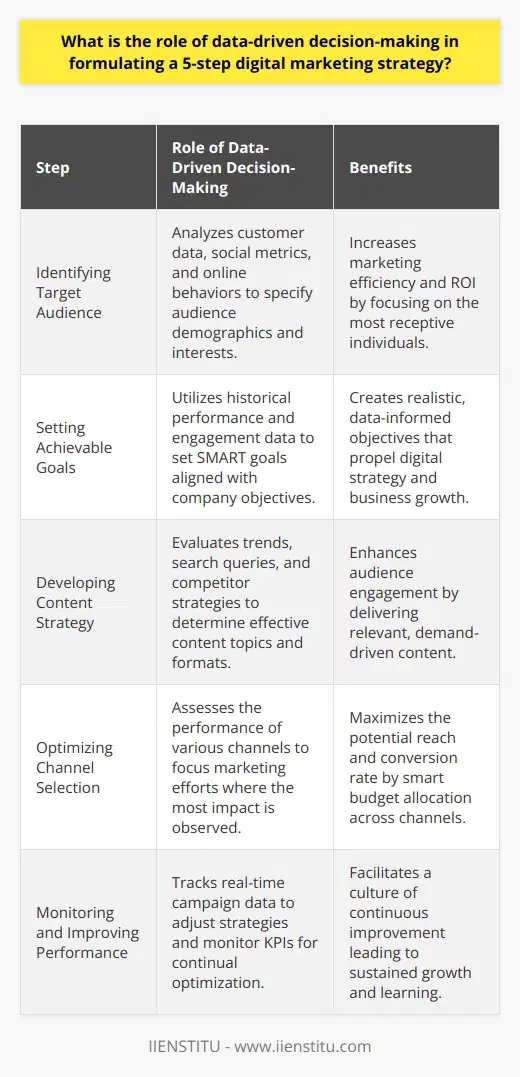
How do the 5 key components of a digital marketing strategy contribute to the overall success of a campaign?
Understanding the Components
To comprehend the role of the five key components in a digital marketing strategy, we must first identify and understand them: content marketing, search engine optimization (SEO), social media marketing, pay-per-click advertising, and email marketing. These components individually and collectively contribute to a campaign's overall success, leaving a profound impact on the target audience and achieving marketing objectives.
Content Marketing: The Core
Content marketing remains the foundation of any successful digital marketing strategy as it fuels other components, such as SEO and social media marketing. By creating valuable, high-quality, and relevant content, businesses can deliver their message effectively, engaging the target audience and establishing trust. This component serves as a long-term instrument for attracting and retaining customers, thereby sustaining the campaign's success.
SEO: Enhancing Visibility
Optimizing the content to improve its visibility in search engine result pages is crucial for the success of a campaign. Search engine optimization (SEO) enhances the content's discoverability by improving online rankings and visibility. This organic approach increases the potential for higher web traffic and customer conversions, positively impacting the overall performance of the campaign.
Social Media Marketing: Expanding Reach
Leveraging social media platforms is vital to maximizing the reach of a marketing campaign. Social media marketing facilitates increased engagement and interaction with the target audience by creating and sharing timely and relevant content. Furthermore, social media works as a multiplier for the content marketing efforts, enabling the campaign to reach a wider audience and fostering brand awareness.
Pay-per-click Advertising: Accelerating Results
While organic marketing efforts are essential, supplementing the marketing strategies with paid advertising can produce quicker results. Pay-per-click (PPC) advertising is an ideal component for businesses looking to accelerate their marketing outcomes. By targeting specific customer segments through well-crafted advertisements, PPC enhances brand visibility and drives potential customer conversions during the critical stages of a campaign.
Email Marketing: Nurturing Relationships
Email marketing, as a component of a digital marketing strategy, plays a crucial role in nurturing and maintaining relationships with potential and existing customers. Through targeted and personalized email campaigns, businesses can directly communicate with their audience, fostering customer loyalty and re-engaging lapsed customers. This approach reinforces the effectiveness of other components, particularly content marketing, further promoting the campaign's overall success.
In conclusion, each of the five key components of a digital marketing strategy plays an indispensable role in contributing to the overall success of a campaign. By understanding and optimizing these components, businesses can build a robust and effective marketing strategy that delivers tangible results, achieves marketing objectives, and ultimately drives growth.
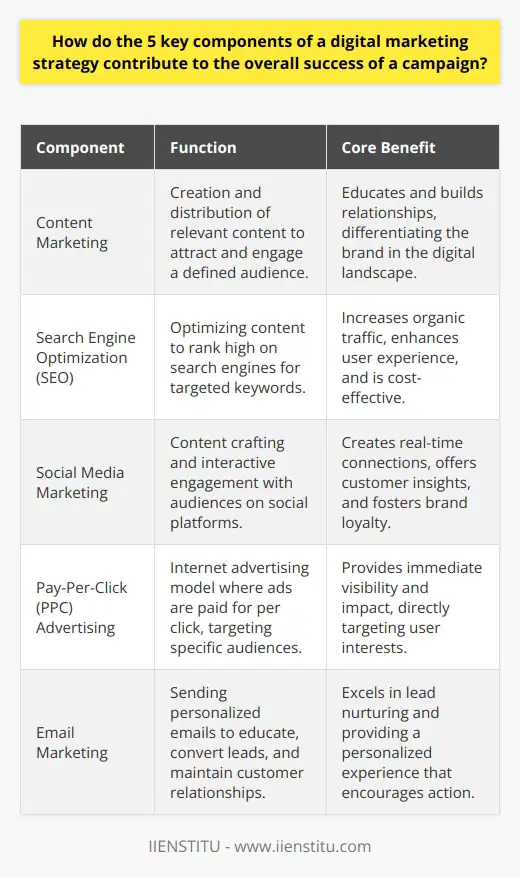
In what ways can the integration of the five digital tools optimize the effectiveness of a digital marketer's efforts?
**Digital Tools for Enhanced Marketing Effectiveness**
*Data Analytics Tools*
Data analytics tools, such as Google Analytics and Adobe Analytics, enable digital marketers to track and assess the performance of their campaigns, helping them identify trends, patterns, and areas of improvement. By leveraging these insights, marketers can optimize their strategies and achieve better results.
*Search Engine Optimization Tools*
Search engine optimization (SEO) tools, such as Moz and SEMrush, aid digital marketers in improving a website's visibility and ranking on search engine pages. By utilizing these tools to identify relevant keywords, analyze competitors, and optimize content, marketers can boost organic traffic and improve their online presence.
*Social Media Management Tools*
Social media management tools, such as Hootsuite and Buffer, allow digital marketers to plan, schedule, and monitor their social media campaigns across various platforms. These tools help streamline workflows, save time, and ensure a consistent brand presence on social media, ultimately leading to higher engagement and conversion rates.
*Email Marketing Tools*
Email marketing tools, such as Mailchimp and Constant Contact, facilitate digital marketers in creating, managing, and tracking email campaigns' efficiency to reach their target audience. Through personalization, segmentation, and automation features, these tools help maximize the effectiveness of email marketing efforts in customer acquisition, retention, and overall satisfaction.
*Marketing Automation Tools*
Marketing automation tools, such as HubSpot and Marketo, empower digital marketers to automate repetitive marketing tasks, collect valuable data on prospects, and nurture leads through personalized and targeted communication. Through automation, marketers can better allocate their time, increase efficiency, and improve their return on investment.
In summary, the integration of data analytics, SEO, social media management, email marketing, and marketing automation tools can greatly optimize a digital marketer's efforts by providing valuable insights, streamlining processes, enhancing target audience engagement, and ultimately, improving overall business performance.
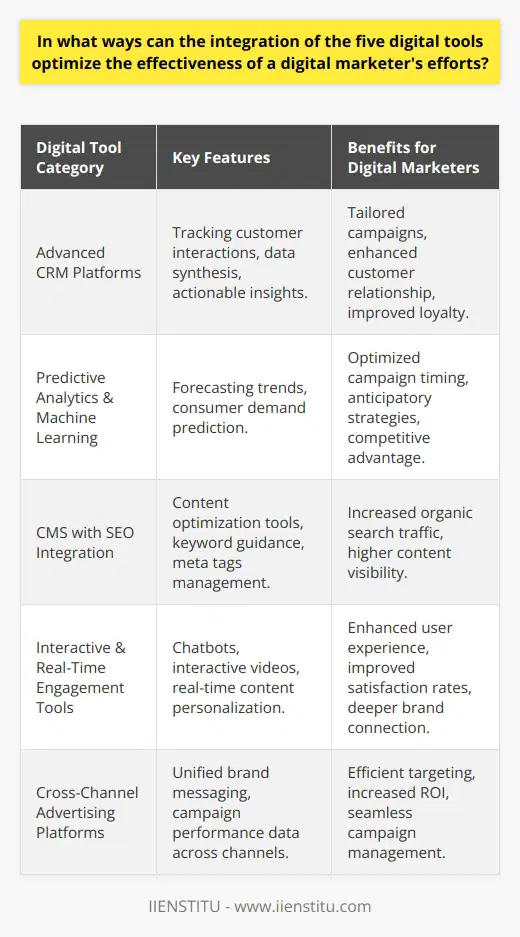
What are the 5 key components to crafting a digital marketing strategy?
Crafting a Successful Digital Marketing Strategy: 5 Key Components
Understanding the Target Audience
It is crucial to have a comprehensive understanding of the target audience, as it allows marketers to create relevant content and tailor their communication strategy. This includes knowing their demographics, preferences, and pain points.
Setting Clear Objectives
Clear and measurable objectives are essential for tracking the progress and efficacy of a digital marketing campaign. This helps to allocate resources strategically, optimize performance, and make data-driven decisions.
Selecting Suitable Digital Channels
It is vital to select appropriate digital channels based on the target audience and marketing goals. These may include search engines, social media platforms, email marketing, content marketing, or influencer campaigns.
Developing Engaging Content
Creating relevant, informative and captivating content is a core component of any digital marketing strategy. This not only attracts more traffic but also nurtures leads and improves conversion rates. Additionally, maintaining a consistent brand voice and messaging across all channels helps solidify brand identity.
Analyzing and Optimizing Performance
Regular analysis and optimization of key performance indicators (KPIs) are critical to the success of any digital marketing strategy. Monitoring campaign performance helps identify successful tactics, detect shortcomings, and revise strategies accordingly for continuous improvement.
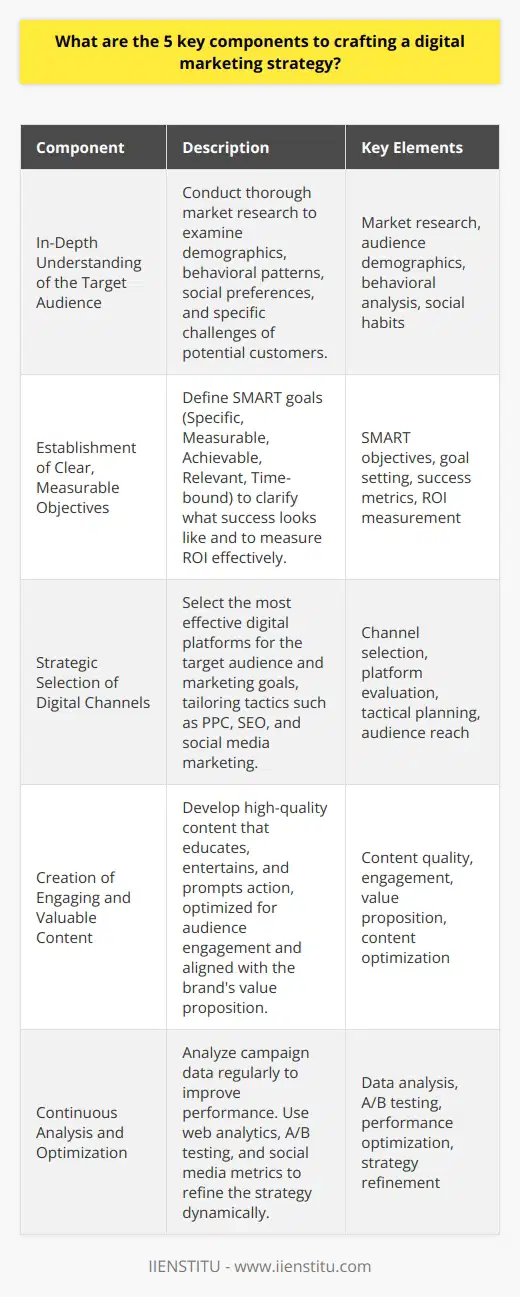
How do the various stages of planning a digital marketing strategy differ from each other, and what role do they each play in the overall campaign?
Understanding the Different Stages
In creating an effective digital marketing strategy, various stages of planning are involved, each with distinct objectives and roles in the overall campaign. These stages include situational analysis, setting objectives, strategies development, tactics implementation, and results evaluation.
Situational Analysis: Assessing the Landscape
The first stage, situational analysis, involves assessing the current digital landscape by examining market conditions, opportunities, and threats, as well as the organization's internal capabilities and resources. This comprehensive evaluation serves as the foundation for informed decision-making and strategy development.
Setting Objectives: Defining Success
Once a thorough assessment is conducted, the next stage involves setting measurable and achievable objectives. These goals must be aligned with the organization's broader aims and help drive the digital marketing strategy. By establishing clear objectives, marketers can ensure direction and focus throughout the campaign.
Strategies Development: Crafting a Roadmap
With objectives in place, the third stage, strategies development, encompasses the creation of a strategic roadmap to guide decision-making and resource allocation. This phase entails the selection of target markets, determining the competitive positioning, and identifying the key digital channels to be utilized. It is crucial that the devised strategies align with the previously set objectives to ensure campaign efficacy.
Tactics Implementation: Bringing Ideas to Life
Following strategy formulation, the fourth stage involves the implementation of tactics, which are the specific actions taken to execute the digital marketing strategy. These tactics may include creating engaging content, utilizing search engine optimization techniques, and leveraging social media platforms. This transition from strategy to execution requires careful planning and coordination to guarantee alignment with the bigger picture.
Results Evaluation: Measuring Success
Finally, the last stage involves evaluating the results of the digital marketing efforts. Measurement and analysis of key performance indicators (KPIs) enable continuous improvement and refinement of the strategy. This stage is critical in determining the effectiveness of the digital marketing campaign and identifying areas of opportunity for future initiatives.
In conclusion, the various stages of planning a digital marketing strategy differ in their objectives, processes, and roles within the overall campaign. Each stage is essential to the success of the strategy, providing a systematic approach to achieving targeted marketing goals. By understanding and carefully navigating these stages, digital marketers can develop and execute campaigns that contribute to the organization's overall success.
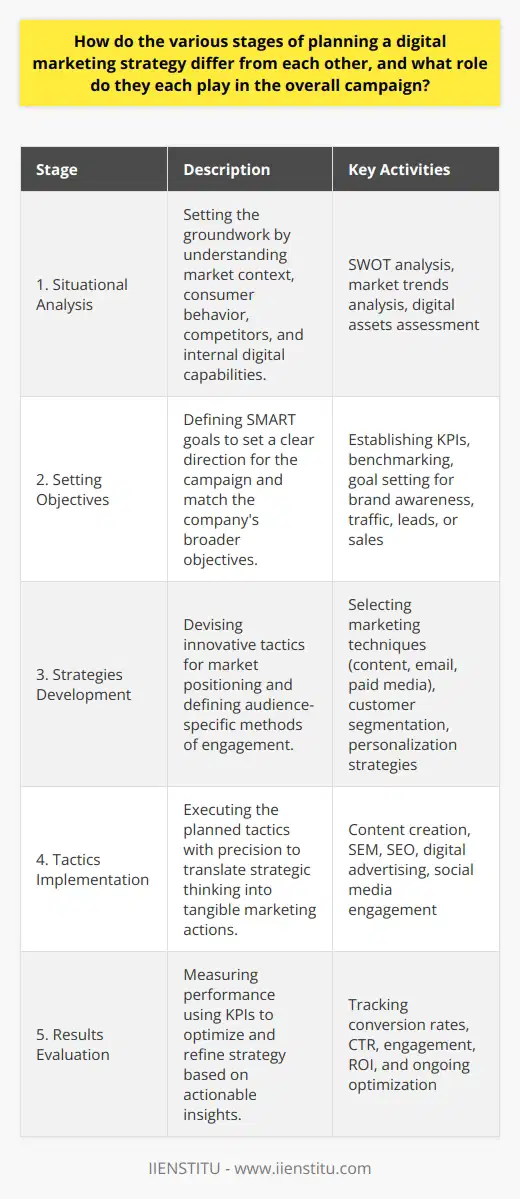
What are some examples of the 5 most effective methods for digital marketing, and how do they contribute to a comprehensive digital marketing strategy?
**Search Engine Optimization**
One effective method for digital marketing is search engine optimization (SEO). SEO aims to improve a website's visibility in search engine results, enhancing organic traffic and brand visibility. By utilizing relevant keywords and structuring content strategically, businesses can achieve higher search rankings to drive engagement.
**Content Marketing**
Content marketing plays a crucial role in a comprehensive digital marketing strategy. Creating valuable and informative content generates interest among potential customers, leading to increased web traffic and sales conversions. A strong content marketing plan consisting of blog posts, videos, and infographics captivates the target audience and establishes a brand's authority in the industry.
**Social Media Marketing**
Leveraging social media platforms grants businesses access to expansive and diverse user bases. Social media marketing enables brands to build and nurture relationships with customers by sharing content, responding to inquiries, and gaining feedback. A robust social media presence fosters customer loyalty and amplifies brand reach.
**Email Marketing**
Another powerful tool in digital marketing is email marketing. By crafting and distributing personalized emails to subscribers, businesses maintain ongoing communication with their audience. Email marketing allows brands to inform customers about exclusive offers, updates, and promotions, enticing them to take action and make purchases.
**Pay-Per-Click Advertising**
Pay-per-click (PPC) advertising is a cost-effective method where marketers bid for ad placement in search engine result pages. It enhances brand exposure to potential customers searching for related products or services. PPC drives immediate and targeted traffic to websites, resulting in higher conversions and return on ad spend with measurable results.
In conclusion, a comprehensive digital marketing strategy harnesses the power of SEO, content marketing, social media marketing, email marketing, and PPC advertising. By integrating these five effective methods, brands increase their visibility, forge relationships with customers, and generate measurable results to achieve their desired marketing objectives.
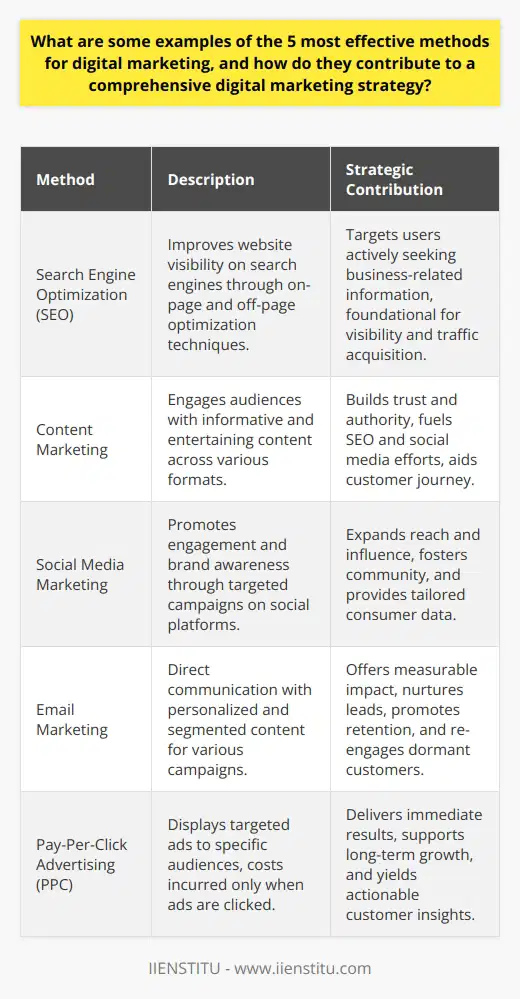
How can the 7 P's of digital marketing be applied to create a well-rounded and effective digital marketing campaign?
Understanding the 7 P's
To create a well-rounded and effective digital marketing campaign, incorporating the 7 P's of digital marketing is essential. These seven fundamental principles provide a framework for marketers to design, develop, and enhance their digital marketing strategies, thus promoting growth and success in their businesses.
Product and Service Offering
The first critical aspect of digital marketing is identifying the right product or service offering for the target audience. This involves a deep understanding of customers' needs and preferences, followed by crafting an irresistible offer that communicates the benefits, features, and unique selling points of the product or service.
Price Strategy
The second essential element is developing a pricing strategy that balances customers' value perception and the company's profit objectives. Utilizing various models, such as competitive pricing, value-based pricing, or penetration pricing, enables marketers to position their product or service optimally in the market.
Place and Distribution
To maximize exposure and reach, a well-rounded digital marketing campaign requires a carefully planned distribution strategy. Selecting the appropriate online platforms – such as social media channels, online retailers, or email marketing – enables businesses to connect effectively with their target audiences and capitalize on potential sales opportunities.
Promotion Techniques
Successful digital marketing campaigns utilize various communication techniques and channels to promote their products and services. Examples include content marketing, search engine optimization (SEO), pay-per-click advertising (PPC), and influencer collaborations, allowing marketers to effectively reach and engage their target audience with persuasive and compelling messages.
People and Targeting
Targeting the right people or audience segments is vital in digital marketing success. By analyzing customer demographics, interests, and online behaviors, marketers can develop personas and undertake targeted initiatives that cater to the specific needs and desires of their primary customers.
Processes and Automation
Efficient processes and automation streamline digital marketing efforts by automating repetitive tasks and optimizing workflow. Embracing tools like marketing automation platforms, analytics software, and customer relationship management (CRM) systems ensure that marketing campaigns are implemented, monitored, and measured with precision and agility.
Physical Evidence and Digital Presence
Lastly, maintaining a robust digital presence by creating engaging and informative content across various online platforms fosters credibility and trust within the target audience. Websites, social media profiles, and customer reviews all serve as digital footprints that establish an organization's reputation in the online sphere.
In conclusion, the 7 P's of digital marketing are crucial for creating well-rounded and effective digital marketing campaigns. By addressing product offerings, pricing strategies, distribution channels, promotional techniques, targeting, processes, and digital presence, businesses can build comprehensive and highly successful digital marketing strategies in today's increasingly competitive online landscape.

What are the main advantages of utilizing a 5-step digital marketing strategy, compared to more traditional marketing approaches?
**Clarity and Direction**
One of the main advantages of utilizing a 5-step digital marketing strategy is the clarity and direction it provides. Traditional marketing approaches can be less structured, leading to vagueness and inefficiency. A 5-step process, such as defining objectives, identifying target audiences, crafting compelling messages, engaging with customers on various channels, and measuring results, streamlines efforts and ensures a greater chance of achieving goals.
**Customer Reach and Targeting**
Unlike traditional marketing methods that rely on broader, more passive approaches, a 5-step digital marketing strategy allows for precise targeting of specific customer segments. This leads to increased reach and engagement, as relevant content and campaigns are tailored to the preferences and needs of identified personas. Additionally, digital channels enable businesses to connect with customers worldwide, ensuring global exposure and scalability.
**Measurable Results**
Another advantage of a 5-step digital marketing strategy is the ability to measure results effectively. Traditional marketing methods, such as print advertising and billboards, lack the granular tracking and in-depth analytics that digital marketing provides. By incorporating measurement as a key step, relevant metrics are monitored continuously, enabling marketers to optimize campaigns and make data-driven decisions. This insight can lead to increased return on investment (ROI) and overall marketing effectiveness.
**Agility and Flexibility**
In contrast to traditional marketing approaches, where campaign changes can be slow and costly, a 5-step digital marketing strategy offers greater agility and flexibility. This allows businesses to pivot quickly in response to market trends, competitor actions, and customer feedback. With the ability to adapt, businesses can maintain relevancy and capture opportunities faster than competitors who rely solely on traditional marketing methods.
**Cost Efficiency**
Finally, implementing a 5-step digital marketing strategy is often more cost-effective compared to traditional marketing approaches. Digital channels like social media, email, and content marketing require less financial investment, and they can be scaled more easily. As a result, businesses can allocate budget more efficiently and maximize long-term ROI, without incurring significantly high costs associated with traditional marketing methods.
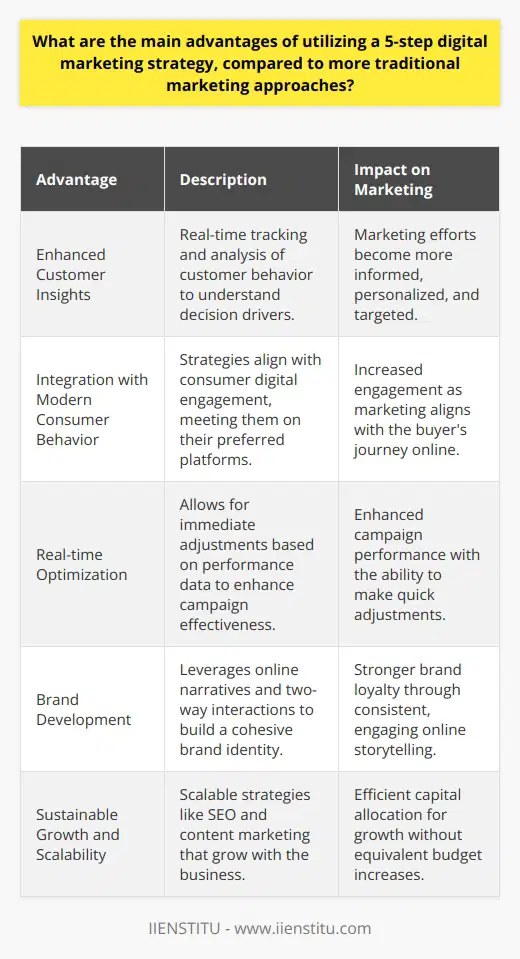
How can the implementation of the 5 key marketing tools enhance the overall performance and efficiency of a digital marketing campaign?
Key Marketing Tools for Campaign Improvement
Enhanced Targeting
The use of key marketing tools allows for enhanced targeting in digital marketing campaigns. By employing tools such as search engine optimization (SEO) and pay-per-click (PPC) advertising, businesses can identify their target audience more effectively, reaching consumers who are searching for specific products or services, thus increasing the likelihood of success in attracting potential customers and driving sales.
Improved Content Strategy
Content marketing plays a pivotal role in digital marketing campaigns, and the utilization of analytical tools enables the development of informed content strategies. By analyzing consumer preferences and behaviors, businesses can create high-quality, relevant content that resonates with their target audience, fostering engagement, enhancing brand awareness and driving conversions.
Personalization and Automation
Personalization is an important aspect of contemporary digital marketing. Integrating customer relationship management (CRM) systems and marketing automation platforms, businesses can craft personalized marketing messages and strategies to connect with their audience on a deeper level. This customized approach enhances the customer experience, increases brand loyalty, and ultimately boosts the overall impact of digital marketing campaigns.
Data-Driven Decision Making
The use of relevant data is paramount for advancing the overall performance and efficiency of digital marketing campaigns. Thorough data analysis and market research equip businesses with critical information regarding their target consumers, enabling data-driven decision making in both marketing strategy formulation and adjustment processes. This evidence-based approach increases the likelihood of a campaign's success, while maximizing cost-efficiency and minimizing resource wastage.
Performance Monitoring and Optimization
Lastly, tracking and monitoring campaign performance via advanced marketing analytics tools is essential for ensuring the ongoing optimization of digital marketing strategies. By assessing key performance indicators (KPIs) such as click-through rates, conversion rates, and return on investment (ROI), marketers can identify areas for improvement, make strategic adjustments, and continually maximize the effectiveness of their marketing campaigns.
In conclusion, the implementation of five key marketing tools - enhanced targeting, improved content strategy, personalization and automation, data-driven decision making, and performance monitoring and optimization - can significantly boost the overall performance and efficiency of digital marketing campaigns. By employing these tools strategically, businesses can foster meaningful connections with their target audience, driving engagement, brand recognition, and ultimately, sales.
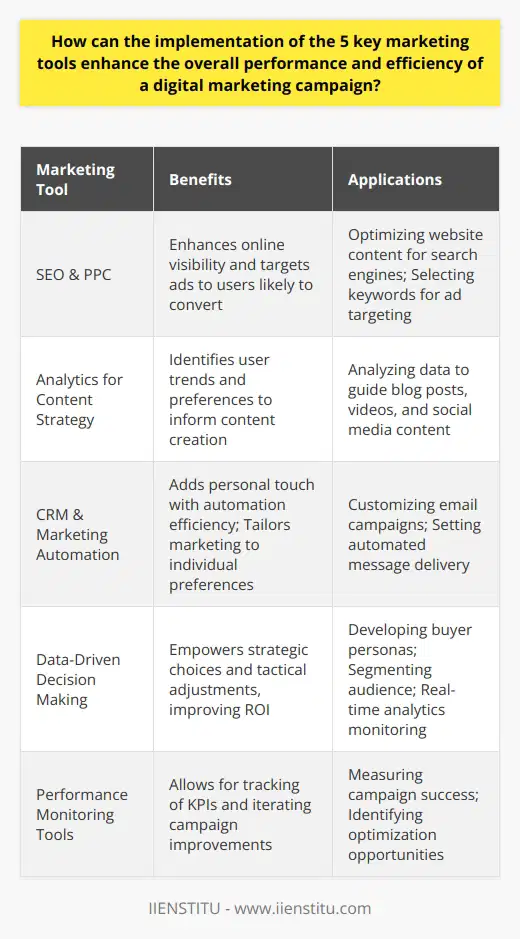
What is the significance of the 7 P's of digital marketing in the development and execution of a cohesive and effective digital marketing campaign?
Significance of the 7 P's Framework
The 7 P's of digital marketing, which include product, price, place, promotion, people, process, and physical evidence, play a crucial role in the development and execution of a cohesive and effective digital marketing campaign. Comprehending and applying these components can enhance the overall marketing strategy, contributing to the success of the campaign in various ways.
Product Relevance and Adaptation
Firstly, understanding the product or service being offered is essential, as it directly influences the marketing objectives and communication messages. Digital marketers must ensure that the product is relevant and adapted to the needs of the target audience to guarantee campaign effectiveness.
Accurate Price Strategy
The price element in digital marketing campaigns is crucial in attracting potential customers and ensuring profitability. Marketers must develop a pricing strategy that promotes perceived value and is competitive within the market.
Online Presence and Distribution Channels
For the place component, it is vital to establish a strong online presence and carefully choose the right digital distribution channels that facilitate easy access to the product or service. Determining the optimal channels is necessary for increasing brand visibility and reaching the desired audience.
Effective Promotion Techniques
Promotion in digital marketing encompasses multiple tactics such as content marketing, social media advertising, and search engine optimization. Utilizing the right mix of promotion techniques allows a digital campaign to maximize its reach and impact on the target audience.
Skillful People and Collaboration
The people component pertains to both the internal staff involved in designing the campaign and the external influencers or brand ambassadors who can amplify its message. Employing skillful, knowledgeable, and experienced individuals leads to creative and well-executed campaigns.
Streamlined Processes
Process efficiency is necessary for operating a smooth and cohesive marketing campaign. Optimal processes enable easy navigation and integration across various digital platforms, contributing to seamless customer experiences.
Physical Evidence Supporting Digital Claims
Lastly, physical evidence in digital marketing refers to any online or offline elements, such as reviews or testimonials, that support the marketing claims made in the campaign. Incorporating such evidence into the campaign strengthens its credibility and persuades potential customers to trust the brand.
In conclusion, the 7 P's framework is of significant importance in formulating and carrying out an effective digital marketing campaign. Their comprehensive approach ensures that marketers address all essential factors while enabling them to deliver a well-rounded and impactful campaign in today's competitive digital landscape.
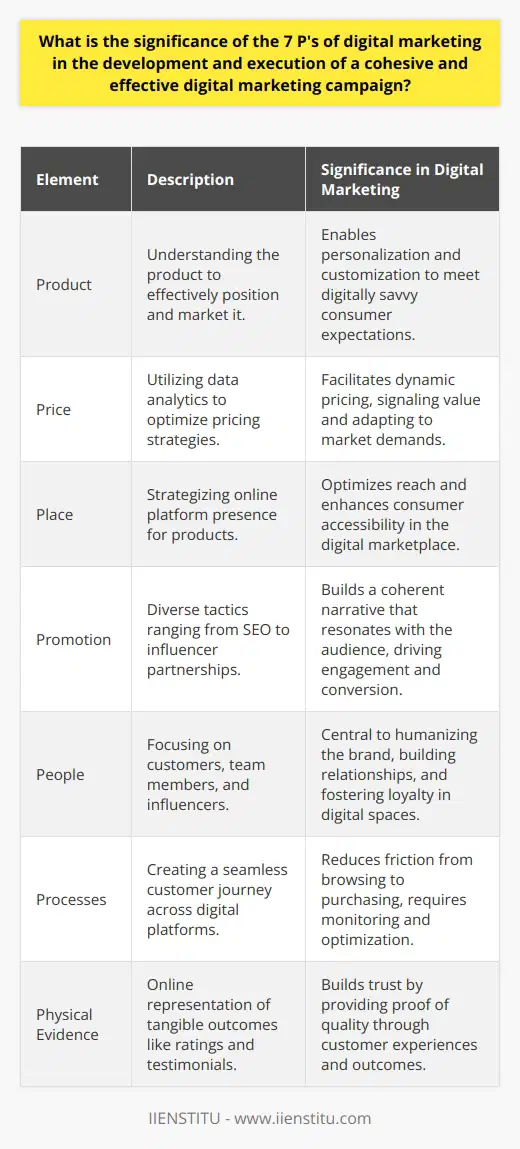
How does a 5-step digital marketing strategy adapt to the ever-changing digital landscape, and what are the main factors that necessitate such adaptability?
Adaptive Digital Marketing Strategy
A 5-step digital marketing strategy can successfully adapt to the ever-changing digital landscape by continuously analyzing consumer behavior, diversifying marketing channels, implementing a flexible content strategy, leveraging data-driven insights, and fostering collaboration between cross-functional teams. These five factors enable businesses to remain agile and responsive to evolving trends and technological innovations in the digital environment.
Consumer Behavior Analysis
The first step in fostering adaptability is consistently monitoring and analyzing consumer behavior patterns. Understanding the target audience's preferences, needs, and motivations helps marketers to tailor their digital strategies accordingly, ensuring relevance and effectiveness in a dynamic online environment.
Diverse Marketing Channels
Next, marketers must diversify their marketing platforms to accommodate ever-changing digital trends. By utilizing a variety of channels such as social media, search engines, email, and content marketing, businesses can consistently reach their target audience while also exploring emerging channels and technologies that could provide a competitive advantage.
Flexible Content Strategy
A flexible content strategy is crucial for adapting to the continuous shifts in consumer preferences and attention spans. Marketers must develop and distribute a wide range of content types to engage and retain their audience, while also being prepared to pivot or modify their content approach based on the performance data and changing market landscape.
Data-Driven Insights
Harnessing the power of data is essential for adapting to the rapidly evolving digital landscape. By utilizing various analytical tools and techniques, marketers can gather valuable insights into the effectiveness of their digital marketing campaigns, leading to informed decision-making concerning optimization and targeting tactics that contribute to the overall adaptability of the strategy.
Cross-Functional Collaboration
Finally, fostering collaboration between cross-functional teams within an organization enhances the adaptability of a digital marketing strategy. Encouraging open communication between marketing, technology, and data teams can result in synergistic efforts and creative solutions designed to address and adapt to new digital challenges and opportunities.
In conclusion, a 5-step digital marketing strategy, with its focus on understanding consumer behavior, diversifying channels, adapting content, leveraging data, and promoting collaboration, is well-equipped to meet the ongoing challenges and changes in the digital landscape. By consistently reviewing and refining their approach, marketers can ensure successful outcomes and maintain a competitive advantage in an ever-evolving digital environment.
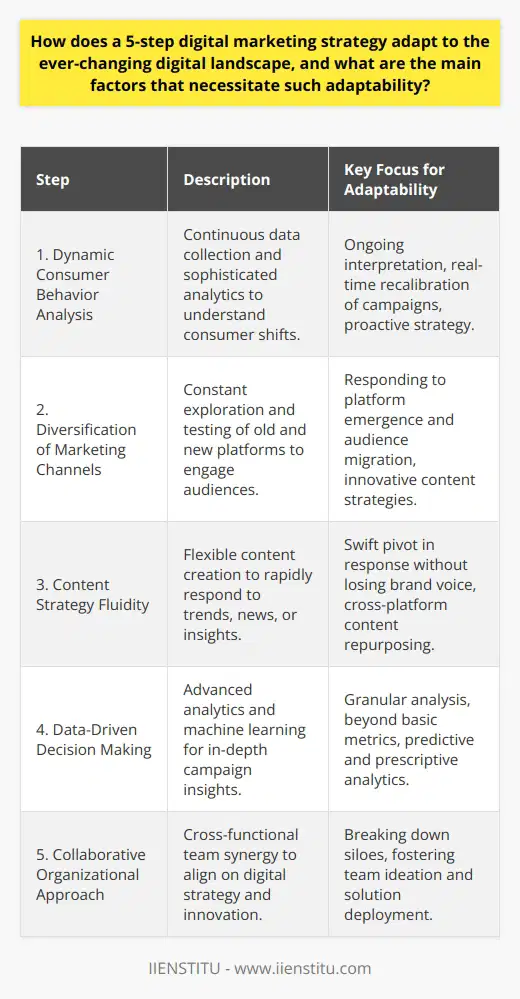
What role do analytics and measurement tools play in adjusting and refining a digital marketing strategy based on the 5 key components?
Role of Analytics and Measurement Tools
Understanding Customer Behavior
Analytics and measurement tools play a crucial role in tracking customer behavior on digital platforms. They provide insights into the target audience's preferences and their interaction with marketing campaigns, enabling marketers to tailor a more personalized and engaging customer experience.
Evaluating Marketing Performance
By employing analytics and measurement tools, marketers can accurately assess the effectiveness of their digital marketing strategies. These tools aid in identifying areas of improvement, quantifying key performance indicators (KPIs), and monitoring the return on investment (ROI) of various marketing initiatives.
Optimizing Campaigns
These tools enable marketers to adjust and refine their campaigns in real-time based on data-driven insights. Marketers can optimize ad placements, messaging, and targeting, allowing them to maximize the engagement, conversion, and overall performance of their marketing initiatives.
Enhancing User Experience
Analytics and measurement tools assist in identifying points of friction in the user experience (UX). By analyzing user behavior data, marketers can make data-driven recommendations to improve UX, decrease bounce rates, and increase overall customer satisfaction.
Competitor Analysis
Lastly, these tools facilitate a comprehensive understanding of competitors' marketing strategies, providing valuable insights into their overall strengths and weaknesses. Armed with this information, businesses can make strategic decisions to outperform the competition in the digital sphere.
In conclusion, analytics and measurement tools play an indispensable role in adjusting and refining digital marketing strategies. By providing valuable insights into customer behavior, marketing performance, campaign optimization, user experience, and competitor analysis, these tools empower marketers to make data-driven decisions and ultimately achieve their desired outcomes.
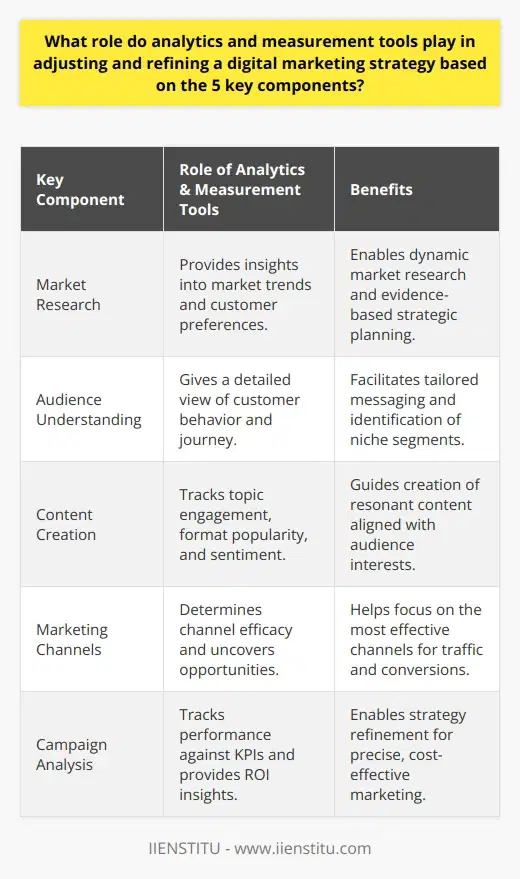
What are the most important considerations when evaluating digital marketing tools in the context of a comprehensive 5-step digital marketing strategy?
Key Factors for Evaluating Digital Marketing Tools
Understanding Business Goals
The primary consideration when evaluating digital marketing tools should be their alignment with the overall business and marketing goals. Considering how these tools can help achieve specific objectives, such as increasing customer engagement, conversion rates, or website traffic, will ensure that they serve the desired purpose within the digital marketing strategy.
Target Audience and Segmentation
Another critical factor is understanding the target audience. Before selecting a digital marketing tool, it is essential to analyze and determine the demographics, preferences, and behavior of the potential customers. Effective segmentation capabilities in the chosen tool allow marketers to create tailored campaigns that resonate with the audience, ultimately driving better results.
Integration and Compatibility
Ease of integration with existing systems and compatibility with other digital marketing tools is a significant consideration. The chosen tool should be adaptable and integrate smoothly with the company's current marketing technology stack. This interconnectivity will ensure efficient data sharing and minimize the risk of disjointed efforts across different platforms.
Budget and Return on Investment (ROI)
An often-overlooked aspect is the budgetary impact of investing in digital marketing tools. It is crucial to weigh the costs involved while evaluating the potential return on investment. Determining the expected outcomes and mapping them against the investment will ensure a decision that provides the best value for money, consequently improving the effectiveness of the marketing strategy.
User Experience and Ease of Use
Lastly, the user experience and ease of use are vital aspects when evaluating digital marketing tools. A tool that has a steep learning curve or is challenging to navigate can lead to wasted time and resources. Selecting a user-friendly and intuitive tool enables marketing teams to operate efficiently, ensuring that the five-step digital marketing strategy is implemented seamlessly and effectively.
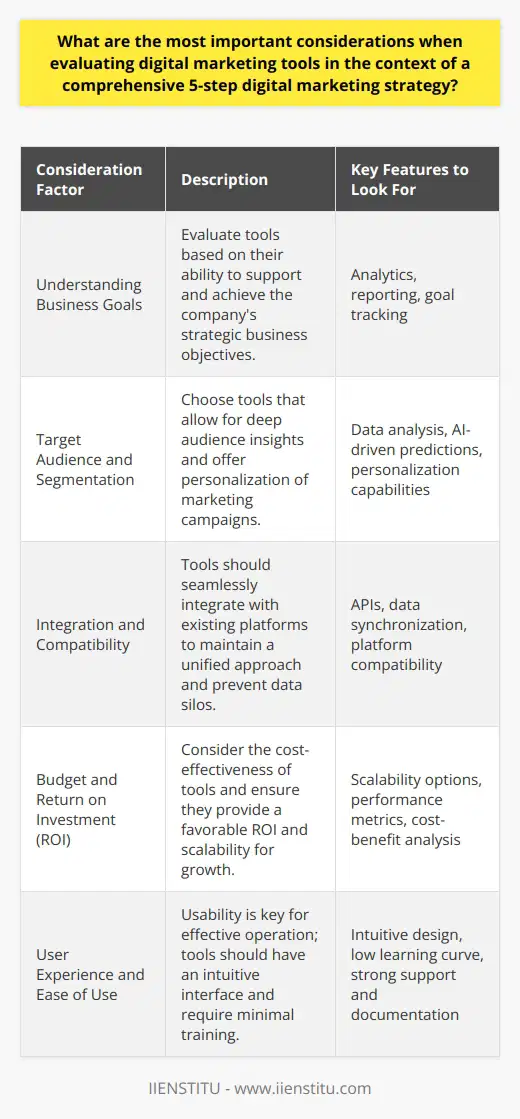
How do the 7 P's of digital marketing provide a framework for creating a tailored and effective digital marketing campaign for various industries and target audiences?
Understanding the 7 P's
The 7 P's of digital marketing - Product, Price, Place, Promotion, People, Process, and Physical Evidence - provide a comprehensive framework that enables businesses to create effective and tailored digital marketing campaigns suitable for diverse industries and target audiences.
Significance of Product and Price
In the context of digital marketing, the Product component refers to the goods or services being marketed. It is crucial to develop a deep understanding of the product's features and benefits, as well as how it addresses the needs of the target audience. Price, on the other hand, involves determining the optimal price point for the product while taking into consideration factors like profitability, competition, and perceived value.
Role of Place and Promotion
Place encompasses the various digital channels through which businesses can reach their target audience, such as websites, social media platforms, or e-commerce sites. Selection of an appropriate channel for the target audience is essential for a successful campaign. Promotion relates to the digital marketing strategies employed to create awareness, generate interest, and engage users, including content marketing, email marketing, and search engine optimization.
Emphasis on People and Process
The People element highlights the importance of understanding the needs, preferences, and behavior of the target audience in order to design an effective campaign. For instance, specific communication styles may resonate better with certain demographic groups. The Process aspect entails the management and optimization of digital marketing efforts, including strategizing, tracking, analyzing, and refining campaign performance.
Physical Evidence Importance
Lastly, Physical Evidence refers to the tangible and intangible aspects of a digital marketing campaign that establish brand credibility and foster consumer trust. This may include the visual design of a website, digital certifications, or the user experience of accessing the product or service online.
In conclusion, the 7 P's of digital marketing provide an exhaustive framework that allows businesses to design and implement tailored digital marketing campaigns that cater to a broad range of industries and target audiences. By considering each of the 7 P's – Product, Price, Place, Promotion, People, Process, and Physical Evidence – businesses can refine their marketing efforts for maximum impact and success in the digital landscape.

What are the key challenges faced by digital marketers when implementing a 5-step digital marketing strategy, and how can these challenges be mitigated through the use of appropriate tactics and tools?
Challenges in Implementing a 5-Step Digital Marketing Strategy
The digital marketing landscape is ever-evolving, with a complex array of platforms and channels vying for consumers' attention. Implementing a comprehensive 5-step digital marketing strategy presents numerous challenges for marketers. In this paragraph, we will discuss the key challenges and propose tactics and tools to overcome them.
Identifying the Target Audience
A common hurdle is identifying and understanding the target audience to develop an effective marketing message. To mitigate this, marketers can employ data-driven tools, such as Google Analytics or social media insights, to garner valuable information about their audience's demographics, behaviors, and preferences.
Remaining Up-to-Date with Platforms and Technologies
Keeping pace with constantly changing technology and platforms is another challenge. By staying informed about industry news and attending webinars or networking events, marketers can remain updated on technological advancements and emerging platforms.
Crafting a Consistent and Engaging Message
Ensuring a consistent brand message can be difficult across various channels. Marketers must implement strong brand guidelines and communication strategies. Additionally, utilizing tools like content calendars or project management applications can help achieve consistency and organization in messaging.
Measuring Success and Analyzing Metrics
To determine the effectiveness of a marketing strategy, it is essential to track and analyze metrics. However, defining the most relevant metrics and interpreting their significance can be tricky. To tackle this issue, marketers can use tools like Google Data Studio to create custom dashboards, focusing on the metrics most important to their success.
Adapting to the Changing Consumer Behavior
Lastly, adapting to fluctuating consumer behavior and preferences presents a challenge. To overcome this, marketers must monitor trend reports, industry news, and consumer feedback to inform and adjust their marketing strategies accordingly. Utilizing social listening tools can also provide insights into consumer sentiments and emerging trends.
In conclusion, implementing a 5-step digital marketing strategy may encompass various challenges, such as identifying target audiences, staying updated on technology, crafting a consistent message, measuring success, and adapting to consumer behavior changes. To mitigate these obstacles, marketers can employ a range of tactics and tools, including data-driven analytics, professional development resources, marketing technology applications, and social listening platforms.
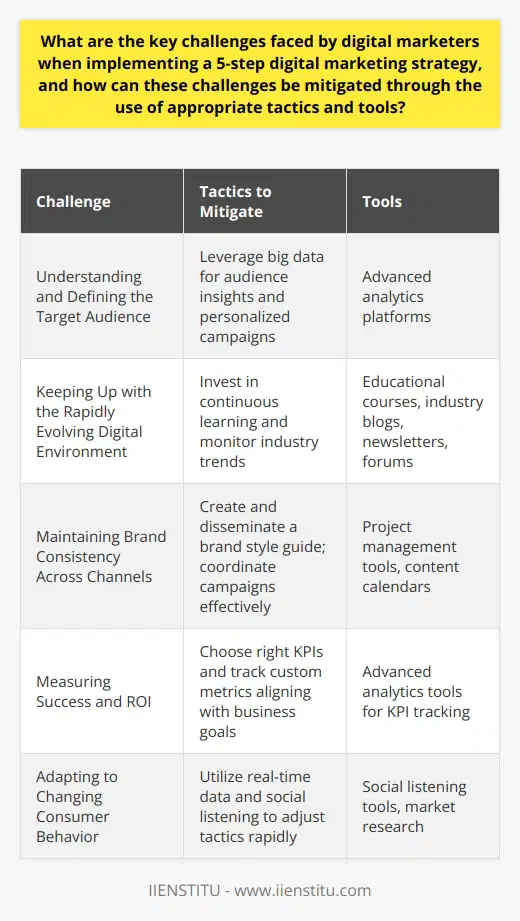
What is the best tools for digital marketing?
Digital Marketing Tools Selection
When choosing tools for digital marketing, the best choice depends on the business's specific marketing goals.
Effectiveness of Social Media Tools
For brand exposure and audience engagement, social options like Facebook, Twitter, and Instagram are ideal. They provide a direct line of communication with consumers, enabling businesses to build rapport and foster loyalty.
SEO and Analytics Benefits
Search Engine Optimization (SEO) tools like Ahrefs or SEMrush are also vital in digital marketing. They assist businesses in improving their online visibility through keyword optimization. Google Analytics tracks user behavior, providing valuable insights on audience preferences and marketing strategy performance.
Email Marketing Efficiency
Email marketing tools such as MailChimp or SendinBlue are significant for nurturing relationships with potential and existing customers. They allow the business to send personalized messages, thereby increasing conversion rates.
Content Marketing Importance
Content marketing tools like Canva or Grammarly can enhance content quality, making it more engaging and error-free. This improved content can attract prospects, boost brand recognition, and demonstrate industry expertise.
Ad Management Necessity
Ad management tools like Google AdWords or Facebook Ads Manager can streamline the advertising process. They let businesses efficiently manage multiple ad campaigns, optimize them for better performance, and analyze their results.
Ultimately, the best tools for digital marketing are those that best align with a business's specific objectives, target audience, and marketing budget. By leveraging these tools, businesses can boost their online presence, interact with customers more effectively, and, most importantly, increase their return on investment.

What is a 5 step digital marketing strategy?
Understanding the Digital Marketing Strategy
A 5-step digital marketing strategy is a clear and concise plan aiming to achieve marketing goals in a digital realm.
Step 1: Establishing Goals
The initial step involves identifying and setting business and marketing objectives. It ensures the marketing efforts align with the business perspective.
Step 2: Identifying Target Audience
Next, it is crucial to know the target audience. It involves understanding potential customers' preferences, behaviors, and demographics to tailor personalized marketing efforts.
Step 3: Content Creation
The third step implies creating engaging content. Content should resonate with the audience profile to capture their interest and trigger positive customer behavior.
Step 4: Choosing the Right Platform
Once the content is ready, the strategy involves selecting digital platforms. Platforms may include social media, blogs, and e-mailers based on the target audience's presence.
Step 5: Analysis and Optimization
The last step entails monitoring and analyzing results. It enables marketers to measure success against goals and optimize strategies based on these insights.
In conclusion, a 5-step digital marketing strategy is crucial to achieve marketing objectives effectively. It ensures a comprehensive, organized approach to engage potential customers in a digital world. By stimulating customer engagement, businesses can nurture leads, convert sales, and foster long-term business growth.
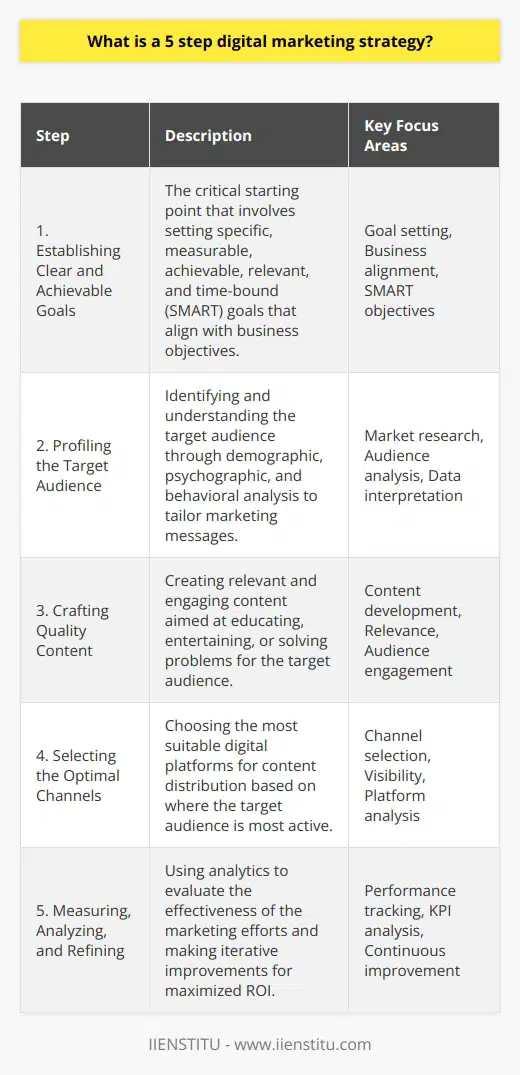
What are the 5 factors of digital marketing?
Digital Marketing Variables
Search Engine Optimization (SEO)
SEO forms a vital aspect of digital marketing, influencing online visibility. By employing strategic keywords and creating quality content, companies increase their search engine rankings and drive organic traffic.
Social Media Marketing
Social media provides a platform for companies to connect with their audiences on a more personal level. Through platforms such as Facebook, Instagram, and Twitter, businesses can promote their products and extend their customer reach.
Content Marketing
Quality and relevant content engages, informs, and leads to conversions. By creating blog posts, videos, and infographics, businesses inspire trust and boost their SEO efforts.
Email Marketing
Email marketing remains effective in nurturing leads and keeping the audience engaged. Personalized email content helps maintain customer relationships and encourages repeat business.
Web Design and User Experience
An efficient website provides a good user experience and enhances conversion rates. Web design plays a crucial role in digital marketing as it impacts how your audience perceives your brand.
